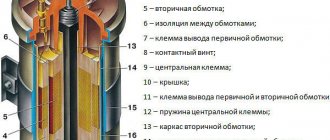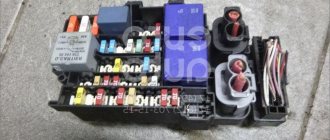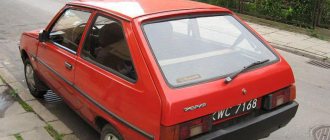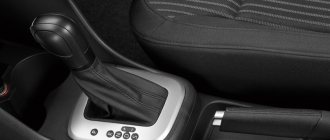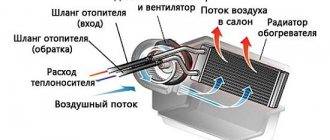Mercedes-Benz vehicles may display a warning message on the dashboard that reads:
- Active Bonnet Fault See Owner's Manual - UK, Europe
- Active Hood Problems See Owner's Manual - USA
Typically you receive this error message when:
- involved in a minor accident
- during emergency braking when the automatic brake is engaged
- hit a pothole or hole on the road
The hood usually rises 5 cm (2 in) at the rear near the windshield.
Although not all Mercedes-Benz models feature the active hood function, it is becoming standard equipment on new models.
This feature was initially available as an option on early 2010 models such as the R172 SLK, but has become standard equipment on models such as the W222 S-Class.
How to reset an active Mercedes hood?
If your hood rides up at the back, follow these steps to close the hood.
- Pull the hood lid and open the hood.
- Keep your hands at the front of the hood and lift until the loops are pushed together and click into place.
- Close the hood.
If the active hood warning message is triggered, you may need to replace your Mercedes hood actuators. Have your Mercedes-Benz checked before replacing any parts.
In some cases, you may need to use a Mercedes-Benz scanner such as iCarsoft MBII, Foxwell for Benz or Autel MaxiDAS to clear error codes from the SRS module.
Once the codes are cleared, pedestrian protection will also be restored.
History of the creation of a pedestrian detection system
Various developers began working on recognition systems for the needs of the army and civilian security systems back in the nineties.
In consumer electronics, facial recognition systems first appeared in Japanese-made cameras at the beginning of the 21st century. In 2010, the Pedestrian Detection System for cars was first offered by Volvo. Currently, in addition to Volvo's PDS, there are TRW's Advanced Pedestrian Detection System and Subaru's EyeSight.
Common reasons
The active hood function is activated and controlled by the primary SRS/Airbag module and the accelerator sensors mounted at the front of the vehicle.
Hood drive
The most common problem that causes active hood malfunctions. See the error message in the owner's manual, this is a hood actuator that is either damaged or has operated after an accident.
The passenger side has a simple locking and unlocking mechanism.
The driver's side has a hood latch, actuator, and a microswitch.
Replacing the Mercedes-Benz hood actuator is a simple procedure. You will need a couple of screws to replace it. Depending on the problem, you may need to clear codes from the SRS module as well.
Sensors
The two acceleration sensors in the bumper and one in the cross member may be damaged or disconnected.
Any of these acceleration sensors could be the culprit if you are getting an Active Hood Trouble See Owner's Manual error and the hood is closed properly or you have never had an accident.
Hood latch
The latch that secures the hood and prevents it from opening has a built-in switch. If the latch is bent or misaligned, such as due to an accident, it may prevent the switch from operating properly.
The hood or latch switch is rarely the cause of active hood malfunctions. See the warning message in the user manual.
SRS module
If the airbag indicator is on, an active hood warning message may appear on the instrument panel even if the hood is closed.
The problem may be due to:
- wiring harness to the hood drive,
- hood drive previously deployed
- The airbag module was unlocked by professional diagnostics during diagnosis.
The hood actuators must be replaced with the hood on and the fault codes cleared from the SRS module.
Further diagnostics
If the airbag light is on and you are receiving the Active Hood Trouble See Owner's Manual , we recommend starting by reading the trouble codes from the SRS module.
You will need a scanner such as Star Diagnostic, or if this is not available, use a dedicated Mercedes-Benz scanner, such as:
- iCarsoft for Mercedes,
- Foxwell for Benz,
- Autel Professional scanner.
Pay attention to trouble codes associated with Active Bonnet actuators.
Manufacturer's recommendations
For the program to function properly, it is recommended to disable the SCBS system of the Mazda CX-5 while driving off-road. There are also several rules that must be followed to ensure correct operation of SCBS:
- all wheels must have the same tires, suitable for the standard size;
- the luggage compartment must not be overloaded;
- It is necessary to promptly clean the windshield from dirt.
The sensitivity of the sensor may decrease due to:
- bad weather;
- high level of pollution of a car moving towards you.
The safety braking system will operate normally provided that:
- trouble-free operation of the motor;
- no software errors;
- driving at speeds from 4 to 30 km/h;
- functioning of the traction control and anti-skid system;
- ride on high-quality and unworn tires.
Mazda cars are rightfully considered one of the most reliable in the world, and the latest safe braking system in the city is proof of this. If the SCBS sensor is working properly, the risk of accidents on the road is minimized.
I would like to exchange experience in using a series of intelligent solutions of innovative technologies i-ACTIVSENSE. By default and in option packages there are: HL - Adaptive lighting system with automatic control of luminous flux; LDW & LKA - lane departure warning systems; BSM - blind spot monitoring system; City safety braking system SCBS (rear); Traffic Sign Recognition System; Driver Attention Alert; Emergency response system for accidents ERA-GLONASS Now let's go through in more detail: 1. Adaptive lighting system (Adaptive LED Headlamps) analyzes the situation on the road at night and automatically adjusts the luminous flux. Thus, the ALH system reduces the brightness of only that part of the high beam headlight beam that can blind oncoming drivers. If a passing vehicle overtakes, the system switches the headlights from high to low. When crossing intersections, the low beam beams of the headlights expand the illuminated area on both sides of the vehicle, which helps the driver notice pedestrians. Also, when you turn the steering wheel, the beam of light also turns. It’s difficult to see exactly how it works, but I can definitely say that the light is simply gorgeous! Especially after three.
Read more: Nissan Qashqai 2008 trunk size
2. Lane-Keep Assist System monitors your vehicle's position relative to lane markings and helps prevent you from unintentionally drifting out of your lane. The driver is first alerted by an audible signal and vibration of the steering wheel. The system then automatically returns the vehicle to the center of the lane if necessary. A very cool thing where you can clearly see the stripes (like in our region), and where there are almost no cars. The car just steers itself) and warnings about driving on the median are displayed. It’s a little scary and you shouldn’t rely on it completely, but it’s an interesting thing!
3. Blind Spot Monitoring system helps the driver control the traffic situation when trying to change lanes. The system monitors a vehicle approaching from behind and alerts the driver to it with a light indicator on the side rear view mirror. Everything is clear here, I’ll only add that it works a little early and sometimes it would be possible to change lanes, but it already squeaks, vibrates the steering wheel and tries a little to return it to the lane. It also shows the danger on the frontal projection (if any) and when leaving a parking lot in reverse, warns that someone is approaching perpendicularly (RCTA).
4. The system of safe braking in the city (Advanced Smart City Brake Support) constantly monitors the distance to the object moving ahead and the speed of approaching it. If the likelihood of a collision increases, the system applies the brakes. In this way, Advanced SCBS minimizes the risk of collisions at speeds of up to 80 km/h. Well, I haven’t been able to try it yet and again there’s no point in hoping) It seems like if you back up, it can also stop the car before a collision.
5. The Traffic Sign Recognition system reads speed limits and “no entry” signs, and if their instructions are violated, it gives an audio and visual alert. When activated, Navi is also automatically activated. It won’t be superfluous either, as long as the signs are in accordance with GOST)
6. Driver Attention Alert. When the vehicle is moving at speeds above 65 km/h, the system monitors the vehicle’s position relative to road markings, takes into account speed, steering angle and travel time. If the driver begins to lose vigilance, the system gives a signal and offers to rest. I can’t say anything - I rarely travel for a long time
Read more: Tire pressure sensors for Infinity Q50
7. ERA-GLONASS is a system for calling emergency services by pressing one button manually or automatically. In the event of an accident or other emergency situation, the system determines the location of the vehicle and transmits the necessary data to the call center. In accordance with the information received, the dispatcher organizes the departure of an ambulance or rescue team to the scene of the incident. "ERA-GLONASS" operates in automatic or manual mode, allowing you to reduce the response time of emergency services by 30%. You know everything yourself - you obliged everyone)) The price has increased by 20-30 thousand for this reason. I hope it never comes in handy. 8. Cruise control. A very useful thing on the highway! Always wanted 9. Auto Hold. Automatically holds the car in a traffic jam after a complete stop. There is no need to hold the brake and when moving away you just need to press the gas. I don’t understand why it needs to be turned on every time from the beginning of the trip ( 10. i-stop, which was not in the top three before, but many already have it. Its operating conditions cannot always be met, the main thing being that the climate must catch up with the set temperature ( not I like the strong flow of air and the noise from it). I don’t see the point of turning it off when traffic jams are crazy, although it kills the battery faster. 11. A bunch of systems that are already clear - HLA - assistance when starting to move on slopes (it doesn’t seem to work sometimes and the car rolls backwards, you have to be careful), EPB - Electronic handbrake (nice, but in winter there may be problems, it seems), ABS, TCS - traction control system (it was also on the troika - it helps or hinders when there is ice), AWD - everything is clear here (it’s a pity that you can’t drive it and it’s not worth the 100 thousand if driving around the city is 99%), I haven’t tried the sport mode (still running in), etc.
The only thing missing in Russia is MRCC(Mazda Radar Cruise Control)- Mazda Cruise Control (MRCC) uses millimeter wave radar to estimate the relative speed and distance of the vehicle ahead and automatically controls the vehicle's speed. Operating within a preset speed range, MRCC automatically adjusts and maintains a safe distance to the vehicle ahead, thereby relieving driver stress on long drives and on highways. Also includes a Distance Recognition Support System (DRSS), which visually displays the next distance to help the driver remain aware of important safety considerations. We didn’t have time to get permission for this thing, so it’s not there yet(
In general, you can do without all this and the price for all this is a little overpriced, I think. And then we’ll see how it all behaves) What do you think about this and how do you use it?
Blind spot monitoring
In August of this year, specialists from the American Insurance Institute for Highway Safety (IIHS) conducted a study in several states and calculated that thanks to the use of such technologies, the number of collisions with cars and pedestrians caught in “blind spots” decreased by 14%, and accidents in which people suffered - by 23%.
Sensors built into the bumpers detect the presence of an object in the “dead zone” of a moving car, and the system sends a signal to the driver, which is reflected in the rear-view mirror. If the driver did not pay attention to it and still turned on the turn signal, then he will also be warned about the danger by sound.
Active monitoring systems, if another car or motorcycle appears in the blind spot, automatically return the car to its lane if the driver decides to change lanes.
Read more: Differential design and principle of operation advantages and disadvantages types
How does the pedestrian detection system work?
When radar sensors and (or) a video camera detect moving objects (in the Subaru system, for example, two cameras are used for this) along the way, the system determines the direction of movement of the pedestrian, the speed of movement and predicts his location at the moment the car appears at the point of detection of the object (the system’s operating range is 40 meters before the object). After making sure that there is an object similar to a pedestrian ahead, the computer displays the image from the camera on the screen of the multimedia system.
If the computer believes that a collision is possible at the current speed of the car and the pedestrian, a sound signal is given. If the driver reacts (turns the steering wheel or presses the brake), the system helps him stop the car using the emergency braking system.
Currently, detection systems guarantee safety at speeds no higher than 30-35 km/h. The recognition algorithm includes samples of typical objects that may be in hands, for example, umbrellas or bags. However, in conditions of poor visibility (due to worsening weather conditions, for example) and at night, the detection system is still useless.
What is the system
When a pedestrian is struck, the active hood opens approximately 15 centimeters.
The pedestrian safety system was first installed on production cars in Europe in 2011. Today the device is used on many European and American cars. Three large companies are involved in the production of equipment:
- TRW Holdings Automotive (makes a product called Pedestrian Protection System, PPS).
- Bosch (makes Electronic Pedestrian Protection, or EPP).
- Siemens.
Despite the differences in names, all manufacturers produce systems that work on the same principle: if a collision with a pedestrian cannot be avoided, the protection mechanism works in such a way as to reduce the consequences of an accident for a person.
Additional devices
To ensure the safety of people who suddenly step onto the road in front of a car, additional devices, systems and design features can be used, which include:
- soft hood;
- soft bumper;
- increased distance from the engine to the hood;
- frameless brushes;
- more sloping hood and windshield.
All of the above solutions will allow the pedestrian to avoid fractures, traumatic brain injuries and other serious health consequences. The lack of direct contact with the engine and windshield allows you to get away with fear and minor bruises.
Sometimes the driver cannot anticipate the appearance of a pedestrian on the roadway. If a person suddenly appears in front of the car, the braking system does not have time to stop the vehicle. The further fate of not only the victim, but also the motorist may depend on the degree of damage caused to the pedestrian’s health. Therefore, when choosing a car, it is important to pay attention not only to the presence of safety systems for the driver and passengers, but also to mechanisms that reduce injuries in the event of a collision with a person.

